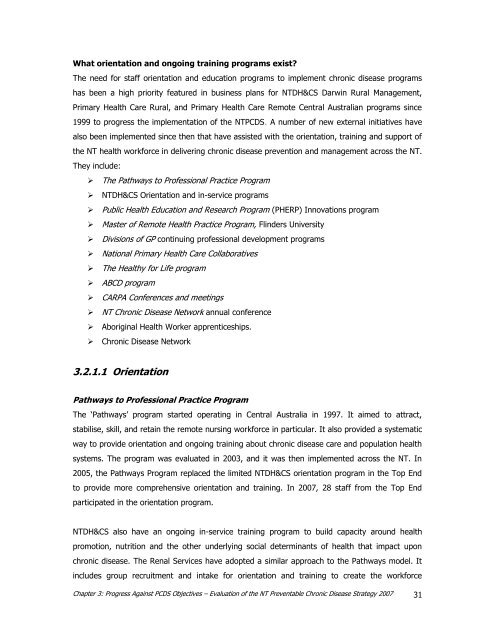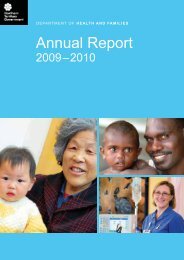PCD Strategy Evaluation 2007.pdf - NT Health Digital Library ...
PCD Strategy Evaluation 2007.pdf - NT Health Digital Library ...
PCD Strategy Evaluation 2007.pdf - NT Health Digital Library ...
You also want an ePaper? Increase the reach of your titles
YUMPU automatically turns print PDFs into web optimized ePapers that Google loves.
What orientation and ongoing training programs exist?The need for staff orientation and education programs to implement chronic disease programshas been a high priority featured in business plans for <strong>NT</strong>DH&CS Darwin Rural Management,Primary <strong>Health</strong> Care Rural, and Primary <strong>Health</strong> Care Remote Central Australian programs since1999 to progress the implementation of the <strong>NT</strong><strong>PCD</strong>S. A number of new external initiatives havealso been implemented since then that have assisted with the orientation, training and support ofthe <strong>NT</strong> health workforce in delivering chronic disease prevention and management across the <strong>NT</strong>.They include:‣ The Pathways to Professional Practice Program‣ <strong>NT</strong>DH&CS Orientation and in-service programs‣ Public <strong>Health</strong> Education and Research Program (PHERP) Innovations program‣ Master of Remote <strong>Health</strong> Practice Program, Flinders University‣ Divisions of GP continuing professional development programs‣ National Primary <strong>Health</strong> Care Collaboratives‣ The <strong>Health</strong>y for Life program‣ ABCD program‣ CARPA Conferences and meetings‣ <strong>NT</strong> Chronic Disease Network annual conference‣ Aboriginal <strong>Health</strong> Worker apprenticeships.‣ Chronic Disease Network3.2.1.1 OrientationPathways to Professional Practice ProgramThe „Pathways‟ program started operating in Central Australia in 1997. It aimed to attract,stabilise, skill, and retain the remote nursing workforce in particular. It also provided a systematicway to provide orientation and ongoing training about chronic disease care and population healthsystems. The program was evaluated in 2003, and it was then implemented across the <strong>NT</strong>. In2005, the Pathways Program replaced the limited <strong>NT</strong>DH&CS orientation program in the Top Endto provide more comprehensive orientation and training. In 2007, 28 staff from the Top Endparticipated in the orientation program.<strong>NT</strong>DH&CS also have an ongoing in-service training program to build capacity around healthpromotion, nutrition and the other underlying social determinants of health that impact uponchronic disease. The Renal Services have adopted a similar approach to the Pathways model. Itincludes group recruitment and intake for orientation and training to create the workforceChapter 3: Progress Against <strong>PCD</strong>S Objectives – <strong>Evaluation</strong> of the <strong>NT</strong> Preventable Chronic Disease <strong>Strategy</strong> 2007 31
















